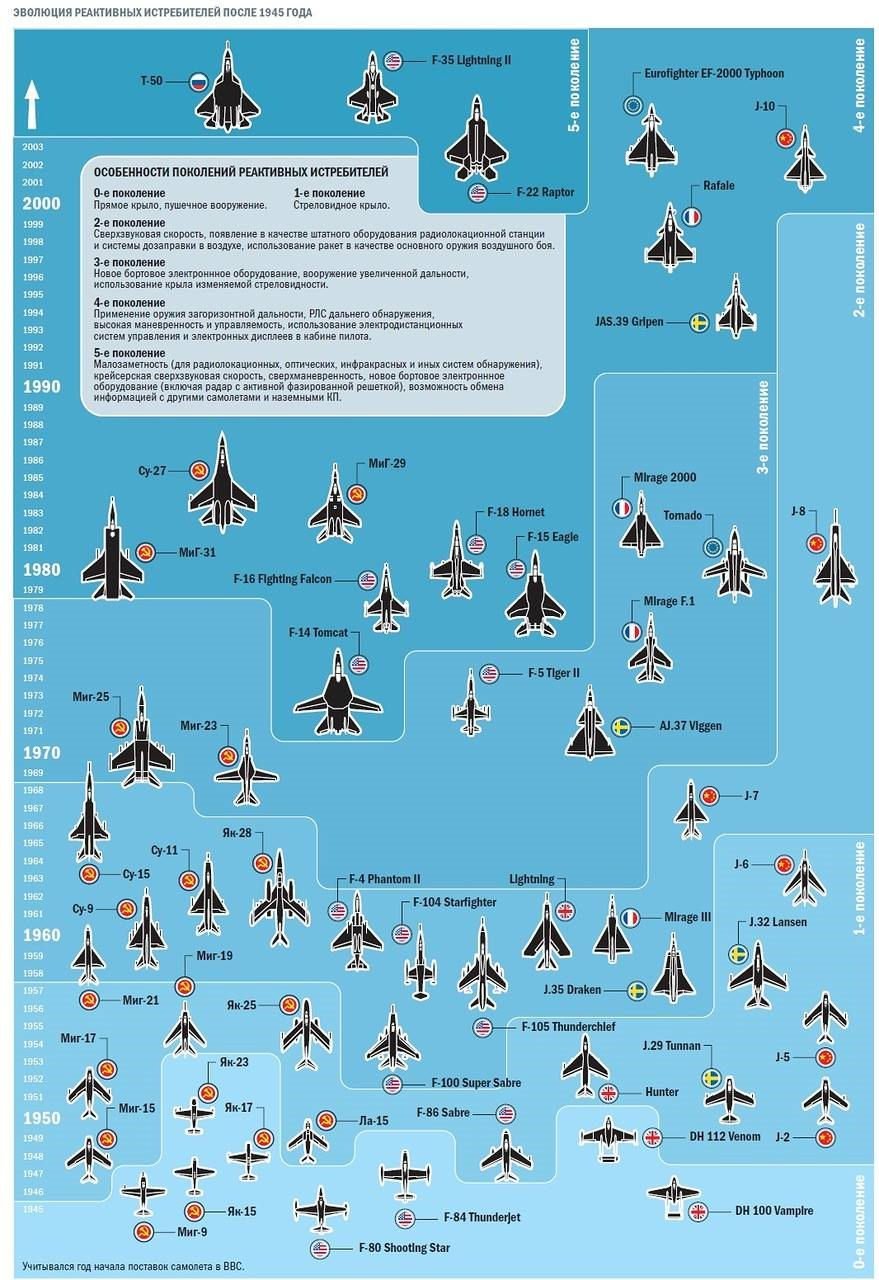This post subject are all jet fighter generations, your features and electronic systems used. This term appear in 1990.
First generation
Emerged in middle of 1940s and were dominant until middle of 1950s. These aircraft were subsonic, because the engines didn’t have afterburners to increase thrust. The operation of jet engines will be subject to another post. The weapons were machine guns, cannons, free fall bombs and non-guided rockets. Some examples of aircrafts from this generation:
- F-86 Sabre (USA):

- MiG-15 (USSR):

- Gloster Meteor (UK):

- Messerschmitt Me-262 (Germany):

- Saab J 29 Tunnan (Sweden):

- CAC Sabre (Australia):

Second generation
Introduced between 1955 and late 1960s. Is the first generation to have a radar, which allows to increase the engagement range and launch air-to-air missiles. This is the radar’s antenna of a F-104 Starfighter from USA.

These aircrafts can reach supersonic speeds thanks to the afterburner in the engines and use infrared guided missiles. However, these sensors were little sensitive and had view angle in maximum 30º. Are divided in two classes: interceptor and fighter-bomber. Also was implemented the concept of delta wing in some aircrafts like the french Mirage III.

Below there are more examples of jets from this generation.
- MiG-21 (USSR):

- F-102 Delta Dagger (USA):

- Chengdu J-7 (China):

- HAL HF-24 Marut (India):

- Avro Canada CF-105 Arrow (Canada):

- Hawker Hunter (UK):

Third generation
Most of them were introduced in 1960s and 1970s. Appears the multirole jet concept, aircrafts which can do many types of missions like air support, ground attack, air superiority, etc. The avionics, weapon systems and aerodynamics are improved. An innovation is the doppler radar with “lookdown/shoot-down”, is the capacity to detect, track and direct a missile to the target. This is the AN/APQ-153, the original doppler radar of Northrop F-5E.

This is the first generation able to hit targets beyond visual range and employ medium range radio guided missiles and laser guided bombs. Some example of jets from this generation are:
- McDonnel Douglas Phantom II (USA):

- MiG-25 (USSR):

- HESA Saeqeh (Iran):

- Saab 37 Viggen (Sweden):

- Dassault-Breguet Super Étendard (France):

- Mitsubishi F-1 (Japan):

Forth generation
Most of them were developed in 1980s, advances in microelectronics and computing allowed the creation of fly by wire systems, which allow to stabilize the airplane and increase maneuverability. The fly by wire needs a dedicated post which will be published in the future.

This generation also has more powerful engines and improved avionics. Was improved the IRST, an infrared sensor which can detects other aircrafts, vehicles and missiles because they emit infrared radiation, by that, heat.

The IRST works independent of radar and depending of weather can be more sensible than the later. It is assembled next to the nose or below the aircraft.

Some jets of 4th generation are:
- F-15 Eagle (USA):

- MiG-29 (USSR):

- Chengdu J-10 (China):

- HAL Tejas (India):

- Mitsubishi F-2 (Japan):

- AIDC F-CK-1 Ching-kuo (Taiwan):

4.5 Generation
This generation exists due to reduction of military spending, limiting the project of new vectors. Was implemented the AESA type radar, of active electronic scanning. Has a sweep between 90º and 120º and can detect and track many target at the same time. This is the AESA of a MiG-35.

This type of radar has many transceivers and can be implemented in forth generation airplanes.

Other differences between this generation and the fourth are highly integrated electronics and high capacity data link, which are protocols of digital data transmission. Some members of this generation are:
- Boeing F/A-18E/F Super Hornet (USA):

- Sukhoi Su-35 (Russia):

- Saab JAS 39 Gripen E/F (Sweden):

- Dassault Rafale (France):

- Eurofighter EF-2000 Typhoon (Germany/UK/Italy/Spain):

Fifth generation
The fifth generation stands out by stealth capacity, be invisible to radar, or at least have very low radar signature. In addition to more sophisticated avionics and high performance engines. Some vectors from this generation are:
- Lockheed Martin F-22 Raptor (USA):

- F-35 Lighting (USA):

- Sukhoi SU-57 PAK FA (Russia):

- Chengdu J-20 (China):

- Shenyang J-31 (China):

Different classifications
The classification of jet fighter generations above is the western, but it isn’t the only one. According to russian classification, there is the 0th generation, which are aircrafts with wing perpendicular to airplane’s body and the first generation are aircrafts with wings in form of arrow.

In the chinese classification, the jet fighter generations are 4, the F-22 is considered fourth generation.
- 1st generation: Introduced in 1950s and 1960s;
- 2nd generation: 1970s and 1980s;
- 3rd generation: 1990s and 2000s;
- 4th generation: 2010s.




Hi there to every one, it’s really a good for
me to pay a quick visit this website, it consists
of valuable Information.
Hi, I am glad you liked.
I am genuinely pleased to glance at this webpage posts which consists of tons of helpful facts,
thanks for providing these kinds of information.